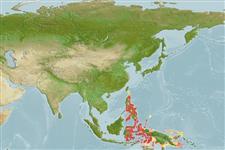Common names from other countries
Environment: milieu / climate zone / depth range / distribution range
экология
морской ассоциированный с рифами; пределы глубины 0 - 30 m (Ref. 9710). Tropical; 23°N - 11°S, 120°E - 154°E (Ref. 5222)
Western Pacific: Vietnam, Indonesia, Philippines, Taiwan, Solomon Islands (Ref. 4787) and New Britain.
Size / Вес / Возраст
Maturity: Lm ? range ? - ? cm
Max length : 30.0 cm TL самец/пол неопределен; (Ref. 5222)
колючие лучи спинного плавника (общее число) : 11; членистые (мягкие) лучи спинного плавника (общее число) : 16 - 17; колючие лучи анального плавника: 3; членистые (мягкие) лучи анального плавника: 8. Characterized by grey brown color with scattered reddish brown to black spots; narrow pale margins on dark grey fins; body scales ctenoid, except cycloid scales dorsally and ventrally; body with auxiliary scales; greatest depth of body 2.8-3.2 in SL; rounded caudal fin; pelvic fins, 1.9-2.3 in head length (Ref. 90102); head length 2.3-2.6 times in SL; interorbital area flat to slightly convex, almost straight dorsal head profile; rounded preopercle, finely serrate, ventral serrae slightly enlarged; straight upper edge of operculum; maxilla reaches past rear edge of eye; 2 or 3 rows of teeth on midlateral part of lower jaw (Ref. 089707).
Found on mud or rocky or cobble bottoms (Ref. 089707). The species appears to be one of the rarest groupers in the Indo-Pacific region, nothing has been published on its biology. Solitary (Ref 90102).
Life cycle and mating behavior
Maturities | размножение | Spawnings | Egg(s) | Fecundities | личинки
Heemstra, P.C. and J.E. Randall, 1993. FAO Species Catalogue. Vol. 16. Groupers of the world (family Serranidae, subfamily Epinephelinae). An annotated and illustrated catalogue of the grouper, rockcod, hind, coral grouper and lyretail species known to date. Rome: FAO. FAO Fish. Synop. 125(16):382 p. (Ref. 5222)
Статус Красного Списка МСОП (Ref. 130435)
CITES (Ref. 128078)
Not Evaluated
Угроза для людей
Harmless
Использование человеком
рыболовство: интереса не представляет
дополнительная информация
инструменты
Специальные отчеты
Скачать в формате XML
ресурсы в Интернет
Estimates based on models
Preferred temperature (Ref.
115969): 27.9 - 29.2, mean 28.8 (based on 557 cells).
Phylogenetic diversity index (Ref.
82804): PD
50 = 0.5000 [Uniqueness, from 0.5 = low to 2.0 = high].
Bayesian length-weight: a=0.01175 (0.00571 - 0.02419), b=3.04 (2.88 - 3.20), in cm Total Length, based on LWR estimates for this Genus-body shape (Ref.
93245).
Trophic level (Ref.
69278): 3.7 ±0.6 se; based on size and trophs of closest relatives
устойчивость к внешним воздействиям (Ref.
120179): средний (среднего размера), минимальное время удвоения популяции 1.4-4.4 года (Preliminary K or Fecundity.).
Fishing Vulnerability (Ref.
59153): Low vulnerability (20 of 100).
